50% of Americans take prescription medicine regularly, according to Consumer Reports.
It wasn’t always like this, though. In the past, people took care of their ailments with natural remedies they found or grew.
Wouldn’t you like to grow your own medicine so you don’t have to rely on expensive pharmaceuticals (which may not always be available)? Here is a small medicinal survival garden plan to get you started.
Raised Bed or Row Medicinal Garden?
The first thing to consider with your medicinal garden is how you want to set it up.
Raised Bed Gardens:
Pros
- Good for small yards
- Drain better than row gardens
- Fewer insects get into the garden, making organic gardening easier
- Less soil and water runoff
- Better for people with back problems
- Don’t have to prepare the soil like with row gardening
Cons
- Must have materials to construct the raised beds
- Will need to find or purchase soil for the garden beds
- Should replenish the soil yearly
Row Gardens:
Pros
- Good if you have lots of space
- Suitable for all types of plants
Cons
- Not ideal for small yards
- Requires work to till the soil
- Must analyze soil each year and add nutrients if necessary
- Susceptible to weeds and pests
For most people, a raised bed is a good choice for a small medicinal garden. You’ll also find it easier to plan it out using a simple spreadsheet or drawing.
Tip: Save money on your raised bed garden by using found items – like the cinderblock raised bed garden below.
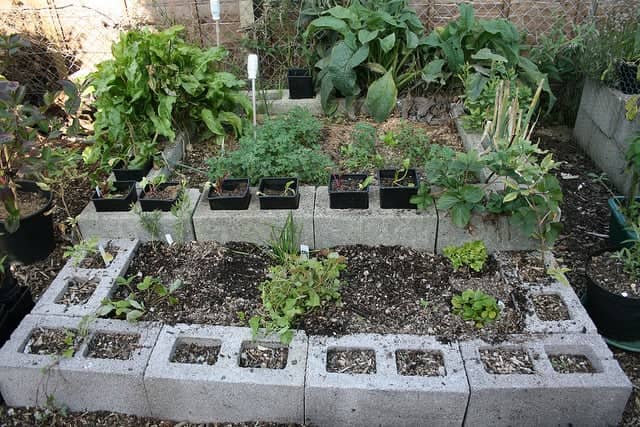
Sizing Your Medicinal Garden
The average yard in America is one-fifth of an acre – or 8,712 square feet. If we all utilized our yards to grow food and medicinal plants, we wouldn’t have to worry about food shortages or crises!
That doesn’t mean you should rush out and turn your entire yard into a garden, though. If you are new to gardening, you should start small.
It’s better to be proud of a small garden than to be frustrated by a big one!
A good size for a single-family medicinal survival garden is 50 to 100 square feet. Of course, this depends on a lot of factors like:
- The size of your yard
- How much of your yard is in ideal growing conditions (sunny area, good drainage)
- Whether you have a vegetable garden too
- How many people your medicinal garden should serve
- What medicinal plants you choose (some require much more space than others)
50 square feet may seem small for a medicinal garden, but you can grow a lot in that space. Here are some examples of raised bed gardens so you can gauge their size.
24 Square Foot Garden
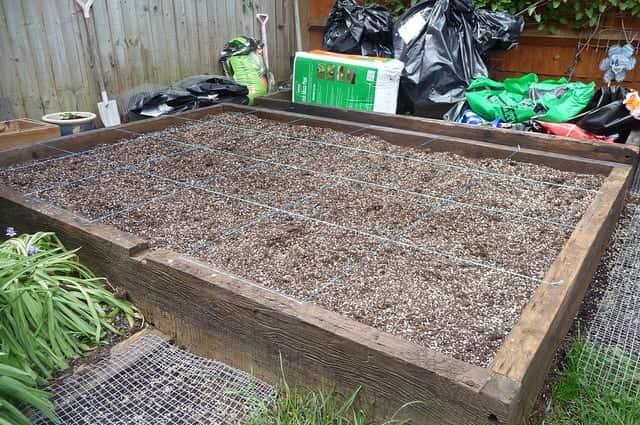
80 Square Foot Garden
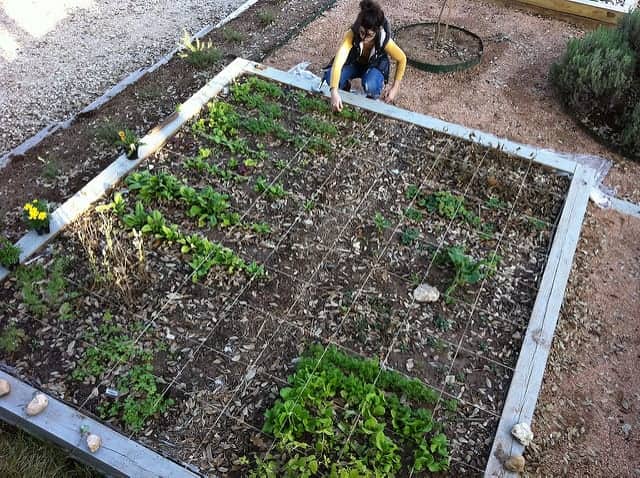
What to Plant in Your Medicinal Garden?
Plants can’t run, fight, or defend themselves as animals can. As a result, they’ve evolved to contain all sorts of chemical defense mechanisms which protect them against disease, fungi, and other ailments. These same chemicals are what also can help us medicinally.
As far as medicinal plants go, there are THOUSANDS of options. How do you go about choosing which plants to grow in your medicinal garden?
You’ll need to narrow down the plants. Here is how:
1. Choose Medicinal Plants with a Variety of Benefits
Calendula, garlic, Echinacea, and yarrow are all great antibacterial herbs – but there is no reason for you to have 4+ antibacterial herbs in your medicinal garden!
In total, you’ll want about 20-30 different plants for your medicinal garden. Aim to include plants that cover all of these medicinal properties. I’ve included some example plants.
- Antibacterial and antiviral: Calendula, garlic, Echinacea, clove, Oregon grape root, marshmallow root, usnea, lemon balm, licorice, oregano
- Burn and dermatological treatment: Aloe, bishop’s weed, calendula, comfrey (Learn how to make comfrey oil.)
- Wound care: Basil, lemon balm
- Digestive aids: Chamomile, licorice, peppermint, Turkish rhubarb, lemon balm, calendula, parsley, fennel, aloe vera, Chinese yam
- Pain killers and anti-inflammatory: Basil, chili peppers, coriander, fennel, garlic, licorice, oregano
- Sedative: Chamomile, lemon balm, valerian
- Urinary tract infections: Uva ursi, yarrow
- Fever: Feverfew, lemon balm, Spilanthes Acmella
- Cough and Congestion: Johnny Jump Up, mullein, thyme, rosemary, peppermint, fennel
- Ear infections: Mullein, Echinacea, Ginkgo Biloba
- Parasite Infections: Artemisia annua, thyme, oregano
If you are already using herbal remedies, then go through your cabinets. See which herbs you use the most and then determine if you could grow them yourself.
Recommended Reading:
- Homemade Pain Relief
- Homemade Cough Medicine
- Antibacterial Medicinal Plants
- Natural Remedies For Diarrhea
- Wild Lettuce: Natural Painkiller
2. Will the Plants Grow in Your Climate?
Choose a few plants to cover each medicinal property. Then check to see if you can grow them in your area.
For this, you will need to figure out the “hardiness” rating of the plant you want to grow. Go to this website and select your state to see its Plant Hardiness Zone.
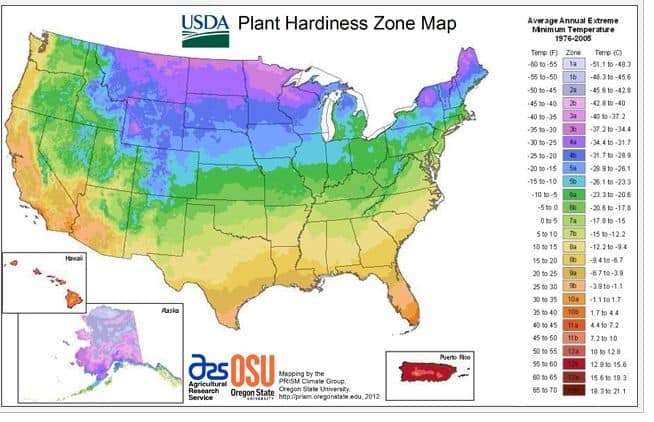
3. Are the Medicinal Plants Difficult to Grow?
If you aren’t an expert gardener, now is not the time to learn how to grow difficult plants. Opt for the easiest plants to grow for your medicinal garden. For example, peppermint has a multitude of medicinal uses and grows like a weed.
4. Do the Plants Have Any Other Uses?
Finally, try to choose medicinal plants which have other uses. For example, the medicinal herbs basil, oregano, and thyme are edible, tasty, and packed with nutrients.
Planning Your Medicinal Garden
By now, you should have a list of plants you want to grow in your medicinal survival garden. All of these plants will be suited to your area and cover a wide range of medicinal properties. Now it is time to map out your medicinal garden!
1. Plant Space Requirements
You should have a list of about 15-30 medicinal plants now. Write down how many square feet a mature plant requires.
As a general rule:
- 1-4 herbs can fit in a square foot of space
- About 4 flowers can fit in a square foot of space
If you can’t figure out how much space your medicinal plant requires, look at the seed packet. It will list the “row spacing” requirements.
If the row spacing is:
- 3” apart (or something smaller), plant 16 per square foot
- 4” apart: plant 9 per square foot
- 6” apart: plant 4 per square foot
- 12” apart: plant 1 per square foot
2. Calculate How Much Space to Give Each Plant
Play around with the numbers of each plant. The square foot requirements of the plants should match up to the square footage of your garden bed.
3. Draw Your Medicinal Garden Plan
It helps to use graph paper for this. Make a scale outline of your garden space. Divide it into square-foot quadrants. Start filling in the quadrants with your plants. Use a different color for each plant.
- Remember the growing needs of each plant. For example, don’t put a bunch of tall plants around a short one as they will block sunlight. This is also known as “companion planting.”
- Keep all of your perennial medicinal plants on one side of the survival garden, and put the annual plants on the other side.
- Group any tall plants facing the south side on the inside of the garden.
Here is an example of how my medicinal survival garden plan looks like.
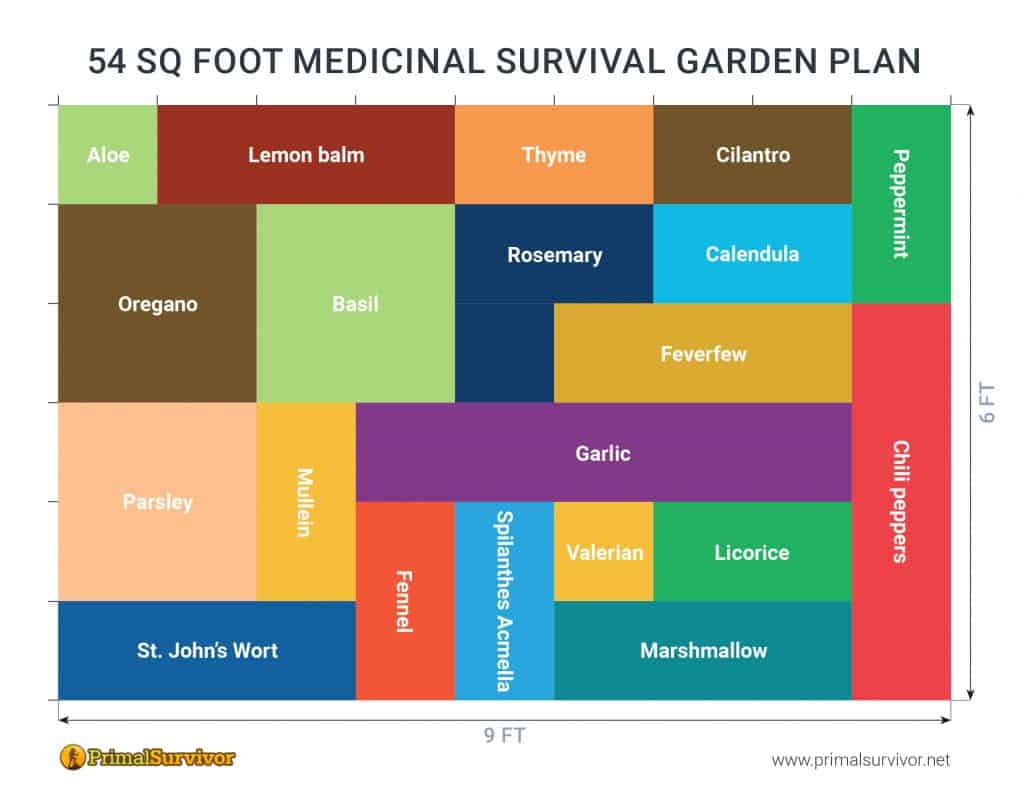
Tip: Buy quality seeds! If your seeds don’t germinate or produce hardy plants, then you’ve wasted your time and money. Investing in quality seeds will pay off during harvest.
Do you have a medicinal garden? Share your tips and comments with us!
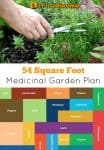


Companion planting isn’t just about making sure one plant doesn’t choke out sun for another. Some plants will provide support, nutrients, and pest control for their companions. I would encourage anyone looking at planting a garden to research this further. Also, consider using life-like fake/toy snakes to keep the birds away. Make sure they are rotated or the birds will wise up and figure out you are fooling them! You can also be sure to plant flowers among your herbs that will attract pollinators like butterflies and bees. Happy gardening!!
I like to have my perennials and annuals in separate beds or a least put the perennials in the middle with the annuals on the outside so it is easy to plant each year.
Do you have any recommendations for where to buy quality seeds for medicinal survival gardens?
I like and have used “Herbal Remedy Gardens” by Dorie Byers
Contains 38 plans with container and outdoor layouts for each, plus basics in utilizing each plant.
Thank you for this article. I’m dreaming up our herbal garden now. Do you need full sun for these types of herb gardens or will 4-6 hours do just fine?
It depends on the plants you choose to put in them. Obviously choose the best plants for your climate and sunlight conditions.
Hello. We’re moving into our first home within the month and I plan on growing medicinally for tinctures. I currently have mullein, but was wondering about how long a tincture would last? Thank you. Your article is amazingly informative!
Alcohol and glycerin tinctures last signifacantly longer than oil extracts. However, some plants (including mucilage plants like mullein!) are best as oil extracts (read about that here – https://superfoodjournal.com/best-mullein-extract/). Oil extracts should ideally be used within a year. An alcohol or glycerin extract will also degrade over time but can last about 5 years.
Regardless of the type, KEEP IT COOL. Heat is the worst enemy of tinctures.
Hi, what a fabulous article you have written here and I really love the quote you put into it….. in my personal past experiences this is so true.
I have looked after a few gardens in my time on this planet and the one that I think of often is the smallest yet manageable one, which gave me a sense of fulfilment and joy.
Not only for the herbs and vegetables I grew also for the wildlife that would visit, after trying various ways we eventually reached a non-verbal agreement about the bounty they could have and what I wanted left alone.
Your information has filled me with such wonderful memories, thank you so very much.
I wish you well and hope that in many years to come when you look back at the gardens you have tended that you to will be filled with similar loving memories like those I have today. Best wishes. Pea
HI there,
This is a great article, well written and very informative. I am very excited to start my own garden incorporating many of the plants mentioned abovery. I do have one question that I hope doesn’t expose me as ignorant to the whole SHTF preparedness agenda. While I’m sure that most, if not all, of these plants can be grown, harvested, and dried. My question is, “once dried and stored, would they retain any of the efficacy of fresh plants, in regards to medicinal, preventative, or curative properties?” I would appreciate any elucidation on the subject.
Thank you again,
Phil Green
Hi Phil, no one needs to feel ignorant or stupid for asking a question. We are a community here and we learn from each other. As regards storing the plants this is not an exact science and there are many variables. The potency of each plant will vary due to soil and growing conditions, the drying process should allow you to retain some of the plants positive benefits and herbs have been used this way for centuries. You may also wish to look at making tinctures or salves from the plants. These methods retain more of the plants healing properties and allow for higher concentrations.